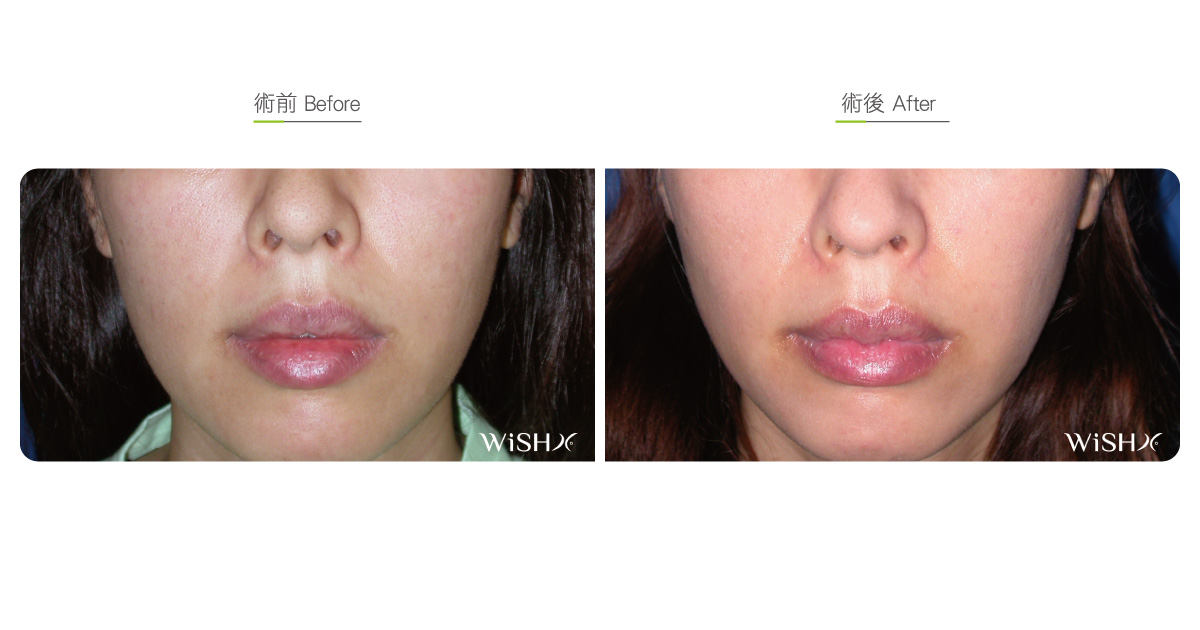Lip Bead Reconstruction
The lip bead (procheilon) is located at the center of the upper lip and is also the highest point of the lip; it is a representation of sexy lips. Apart from esthetic defects, the absence of the lip bead is likely to bare the incisor teeth or tooth crevice, depriving the natural closure of both lips. Generally, such problems arise from congenital lip underdevelopment or hereditary lip shape and in a minority of cases are caused by acquired lip defects from trauma. The correction method is dependent on the severity of lip bead defects. Lips with mild symptoms can be modified by nonsurgical methods, such as the injection of hyaluronic acid or Aquamid, or the injection of autologous fat to obtain temporary effects, which delivers immediate and effective improvement. However, for obvious or extensive lip bead defects, lip bead reconstruction should be considered for radical correction.
Lip bead reconstruction (also called procheilon plastic surgery) sculpts the plump or projected appearance of the lip bead, so the skin around the upper lip is utilized as the surgical material. The method employed by Dr. Chuang is the transfer of V-Y rotational flaps at both sides of the upper lip. First, the skin at both sides of the procheilon is separated as a V incision, and the local lip flap with blood circulation is turned over, transferred and stitched to the central procheilon to sculpt the plump shape of lip bead. This method not only provides sufficient lip flesh for lip bead sculpting but also reduces the skin at both flanges of the upper lip to help remodel the M-shaped lip. The upper lip wound is stitched after lip bead sculpting is completed, and there is no need to remove the stitches. This is currently the most effective and safest procheilon plastic surgery.
Surgical conditions
Duration
- Type of anesthesia: IV sedation + local anesthesia
- Type of incision: At both medial margins of the upper lip and procheilon
- Recovery: 5–7 days
- Removal of stitches: No
General instructions
No food and water on the day of surgery
- Avoid smoking, alcohol, and irritating foods for 1 month postoperatively, and avoid laughing or singing and other overt mouth opening behaviors.
- Abstain from licking the lips to avoid the proliferation of the procheilon scar in the future.
Ideal candidates
- Patients with congenitally distinct lip bead defects or exposure of tooth crevice
- Those with a flat upper lip and no procheilon line
- Those with a lip bead defect due to trauma or prior surgery
- Those who subjectively feel that the lip bead is insufficient
Possible complications
- Scar contracture
- Excess lip resection
- Temporary paresthesia
Surgical advantages
-
It resolves radical procheilon defects by surgeries, with distinct and permanent results.
-
The lip bead feels identical to other sites of the lip.
-
The surrounding lip flesh is used to augment the lip bead, and the facial expressions of the lips are natural.
-
It avoids the inconvenience and cost of the repeated sculpting of the lip bead like filler or fat injection.
Surgical drawbacks
-
The lips may show temporary numbness.
-
The results of lip bead sculpting may differ along with the thickness of the available lip flesh at both sides of the upper lips.
-
The lips may show temporary scar tightening.

